 |
World History
Bloody Passovers Reported by
a Jewish Scholar
Marian T. Horvat, Ph.D.
When I heard that a respected Jewish scholar had written a book affirming the ritual murders of Christian children by Jews, I wanted to read it. An e-mail ad I received announced that the Italian printing house Il Mulino was releasing Prof. Ariel Toaff’s new work, Bloody Passover: Jews of Europe and Ritual Homicide (Pasque de Sangue), (1) in early February 2007.
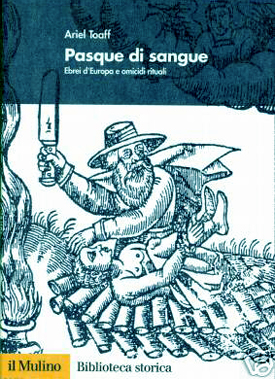
The controversial book by Toaff pictures the sacrifice of Abraham on its cover |
Ariel Toaff is a professor at Bar-Ilan University in Israel who made a name for himself for his study of medieval Jewry. (2) He also happens to be the son of Elio Toaff, former chief rabbi of Rome.
That such a historian was demonstrating that crucifixions of Catholic children did in fact occur in Ashkenazi Jewish communities in the medieval period was big news. Further, he based his conclusions in good part on the trial records of the famous case of St. Simon of Trent, which he had found worthy of belief. More big news, especially since after Vatican Council II, the Vatican examined the same records, decided they were unreliable, and discontinued the popular cult of St. Simon of Trent.
I saved the page, determined to purchase a copy of the book for review after its release. Some months later, when I finally got around to making the purchase, I learned that Bloody Passovers had raised a titanic storm in Jewish and academic circles. The book sold out its 3,000 copies the first week, and then was pulled by the author off the market, never to return.
Controversy & pressure
The controversy was set into motion February 6, two days before the book’s official release, when the Italian magazine Corriere della Sera ran an approving review by Sergio Luzzatto, professor of Modern European History at the University of Turin. The piece ran under the expressive title: “Ariel’s Toaff’s Disconcerting Revelation: The Myth of Human Sacrifice Is Not Just an Antisemitic Lie.”
According to Luzzatto, Toaff’s “courageous” book argues that some Christian children, “or perhaps even many,” were killed by Ashkenazic Jews between 1100 and 1500. Furthermore, Toaff described unleavened bread baked with dried blood, possibly taken from murdered Catholic children. Toaff also affirmed that the accusation against the Jews of Trent in the case of the murder of St. Simon of Trent “might have been true.” (3)
That review raised quite a furor. There was an immediate response from the professor’s father Rabbi Toaff and 12 other senior rabbis of Italy. They issued a joint statement condemning the book and denying the use of human blood for ritual purposes, stating that the only blood shed in any past centuries was “that of many innocent Jews.” (4)
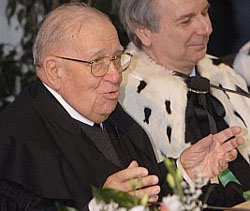
Msgr. Rogger follows the fashion and condemns Toaff |
In Israel, Knesset members urged legal authorities to bring Prof. Toaff to trial over his book Bloody Passovers. MK Marina Solodkin proposed filing civil suits against him for having damaged "historic truth and the reputation of the Jewish people." (5)
Abraham Foxman, chairman of the Anti-Defamation League (ADL), immediately made a public statement calling the whole thesis ridiculous. “It is incredible that anyone, much less an Israeli historian, would give legitimacy to the baseless blood accusation,” he stated. (6)
Catholic scholars, such as Msgr. Ignio Rogger, the Church historian who led the investigation in the 1960s in the St. Simon of Trent case, jumped on the bandwagon condemning Toaff’s research. Rogger said Toaff had not presented any new documents and that he gave credence to confessions extracted under torture; therefore Toaff’s thesis was unsustainable. In fact, not a single historian dared come to his defense. (7)
At first, Bar-Ilan University remained calm, summoning Prof. Toaff to ask for explanations regarding his research. But as the pogrom against the Jewish professor swiftly escalated, University heads issued a condemnation against “any attempt to justify the awful blood libels against Jewish people.” Prof. Toaff’s career was on the line.
It must be said that at the beginning of the attack, Toaff stood resolutely behind his research, insisting there was factual basis for some of the medieval blood accusations against the Jews. “I will not give up my devotion to the truth and academic freedom even if the world crucifies me,” he dramatically stated. (8)
But his resistance didn’t hold out long. Under such strong, widespread coercion, a week after the publication of Bloody Passovers, Toaff published a full apology, stopped distribution of his book, and promised to rewrite problematic parts. To appease the powers that be, he announced that all the profits from its sale would be donated to the Anti-Defamation League.
The case of St. Simon of Trent
According to the reviews I read, what Toaff discovered was that the fundamentalist Ashkenazi Jews did actually steal and crucify Catholic children, obtaining their blood and using it for religious rituals, especially at Passovers. (9)
In particular, Toaff looked at the case of St. Simon of Trent, a two-year-old boy from the Italian town of Trent kidnapped by Ashkenazi Jews from his home on the eve of Passover 1475. He was murdered, his body mutilated and crucified head down. The killers were apprehended, confessed and found guilty by Bishop Hinderbach of Trent. Fifty years later, Pope Sixtus IV assembled a commission of six cardinals chaired by the best legal mind of that time for a retrial, and this court also found the murderers guilty. Records of the trial have survived for centuries.
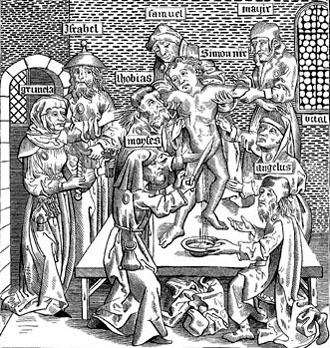
A woodcraft from the Museum of Trent representing a group of Jews inflicting tortures on St. Simon of Trent |
St. Simon’s worship was approved in 1588 by Pope Sixtus IV, and every year the town of Trent celebrated his feast with processions and fanfare - until 1965. In that year, to foster better relations with the Jews after Vatican II, Paul VI ordered the Trent case to be re-examined, and ruled that the confessions of the killers were unacceptable because they were obtained under torture. A decree forbade the cult of St. Simon of Trent. His cult was discontinued and prohibited, and the remains of the martyred child removed and hidden to avoid resumption of pilgrimages.
In his research, Dr. Ariel Toaff made a thorough examination of those court records preserved at Trent. His discovery was that the confessions of the killers contained material that could not have been known to the Italian churchmen or police. The secret rites practiced by the Ashkenazi community, which could not have been known by the judges, were faithfully reproduced in the confessions. Toaff told Haaretz News: “I found that there were statements and parts of the testimony that were not part of the Christian culture of the judges, and they could not have been invented or added by them.” (10)
Such data would seem to at least deserve a fair reading. One might expect that the Vatican in particular would welcome the confirmation by a Jewish scholar of the past findings of Church authorities in the Trent court hearings. But sadly, no hearing or welcome was forthcoming. Toaff discovered many cases of bloody sacrifices connected with the mutilation of children, the outpouring of blood and its baking in Matzo (unleavened Passover bread). The flood of blood accusations in the South Tyrol and upper Veneto at the end of the 15th century, were grounded in facts, according to Toaff’s research. Another Jewish scholar, Kenneth Stow, provides this summary of several chapters of Bloody Passovers:
“Discussions of the negativity Jews expressed about Christianity during the festivals of Purim and Passover and the prominence of blood-imagery especially in Passover rituals (chapters 10 and 11) are followed by the opening words to chapter 12, which say ‘The use of the blood of Christian children in the celebration of Passover was apparently framed by precise rules, or at least this is what the deposition to the Trent trial indicate.” (11)
What Toaff’s study certainly demonstrates is that the Catholic-Jewish antagonism of the Middle Ages was not a one-sided bias on the part of the Catholics, as it is generally presented today. But any discussion on this topic or the general thesis of Bloody Passovers - that Jews crucified Christian children and used their blood ritually - was summarily closed before it could start.
No objections permitted
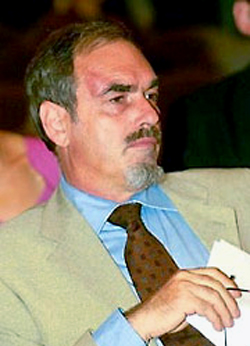
Toaff was forced to withdraw his book |
It is interesting to note that the strongest objections to Bloody Passovers came from those who obviously never read the book. The “reasoning” was this: If it is against the Jews, it is wrong, that’s all there is to it.”
We are simply supposed to dismiss as anti-Semitic ranting any argumentation, even data presented by a serious Jewish scholar, which would uphold that the Catholics could have been justified in their claims that Jews in the Middle Ages practiced blood libel, Kabbalitic black magic, and child crucifixions.
In principle, I regard Toaff’s testimony and research as scholarly, honest and authentic. I consider that the enormous psychological pressure he underwent that induced him to take his book out of circulation and apologize is equivalent to physical torture. Anyone with a little experience in law knows that an apology like Toaff’s, made under such violent and universal pressure, is worthless. Therefore, I don’t considerer his apology as a scholarly denial of his long research, and deem the assertions in his book valuable.
It is a pity that the book is no longer available. If any of my readers have it and would make a copy and send it to me, I would like to make a very detailed review of his arguments.
1. Pasque di sangue, ebrei d’Europa e omicidi rituali (Bologna: Il Mulino, 2007), 325 pp.
2. His works include The Jews in Medieval Umbria (1979), and The Jews in Umbria (3 vols., 1993-4), and Love, Work and Death: Jewish Life in Medieval Umbria, (1998). Toaff is the acknowledged master of the social history of Umbrian Jewry.
3. “Scholar Pulls Book Revisiting Blood Libel,” February 26, 2007, The Jewish Daily Forward online)
4. Arutz Sheva Israel National News online, June 14, 2007)
5. “MKs seek to try Prof. Toaff over claims in blood libel book,” Haaretz.com online, February 27, 2007.
6. “Scholar Pulls Book Revisiting Blood Libel,” op. cit.
7. “Bar-Ilan prof defiant on blood libel book ‘even if crucified,’” Haaretz.com online, February 28, 2007
8. Ibid.
9. From the book review of Kenneth Stow, Prof. Emeritus of Jewish History at Un. Of Haifa: “To begin with, the thesis of Pasque di sange is unambiguous: Jews crucified Christian children and used their blood ritually. The author’s disclaimers … are unpersuasive.” Storicamente website
10. “Scholar Pulls Book Revisiting Blood Libel,” op. cit.
11. Kenneth Stow, “Blood Libel: A Book Full of Sound and Fury,” Storicamente website. Stow vehemently opposes Toaff’s work, his chief argument being that Toaff trusts too much in the words of Catholic chroniclers and court notaries.

Posted October 4, 2007

Related Topics of Interest
 Is the Catholic Church Becoming a Branch of the Synagogue? Is the Catholic Church Becoming a Branch of the Synagogue?
 John Paul II Blessed by the Rabbis John Paul II Blessed by the Rabbis
 Benedict's Visit to the Synagogue of Cologne Benedict's Visit to the Synagogue of Cologne
 The Rational of Judgment The Rational of Judgment
 The King of Spain Dishonors the Golden Fleece Order The King of Spain Dishonors the Golden Fleece Order
 Papal Knighthood Given to a Jewish Rabbi Papal Knighthood Given to a Jewish Rabbi
 Vocations of the European Peoples Vocations of the European Peoples

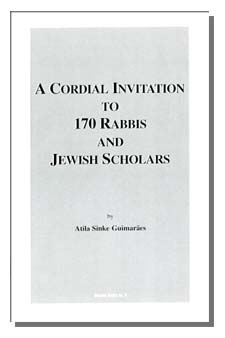

|
History | Home | Books | CDs | Search | Contact Us | Donate

© 2002- Tradition in Action, Inc. All Rights Reserved
|
 |
|